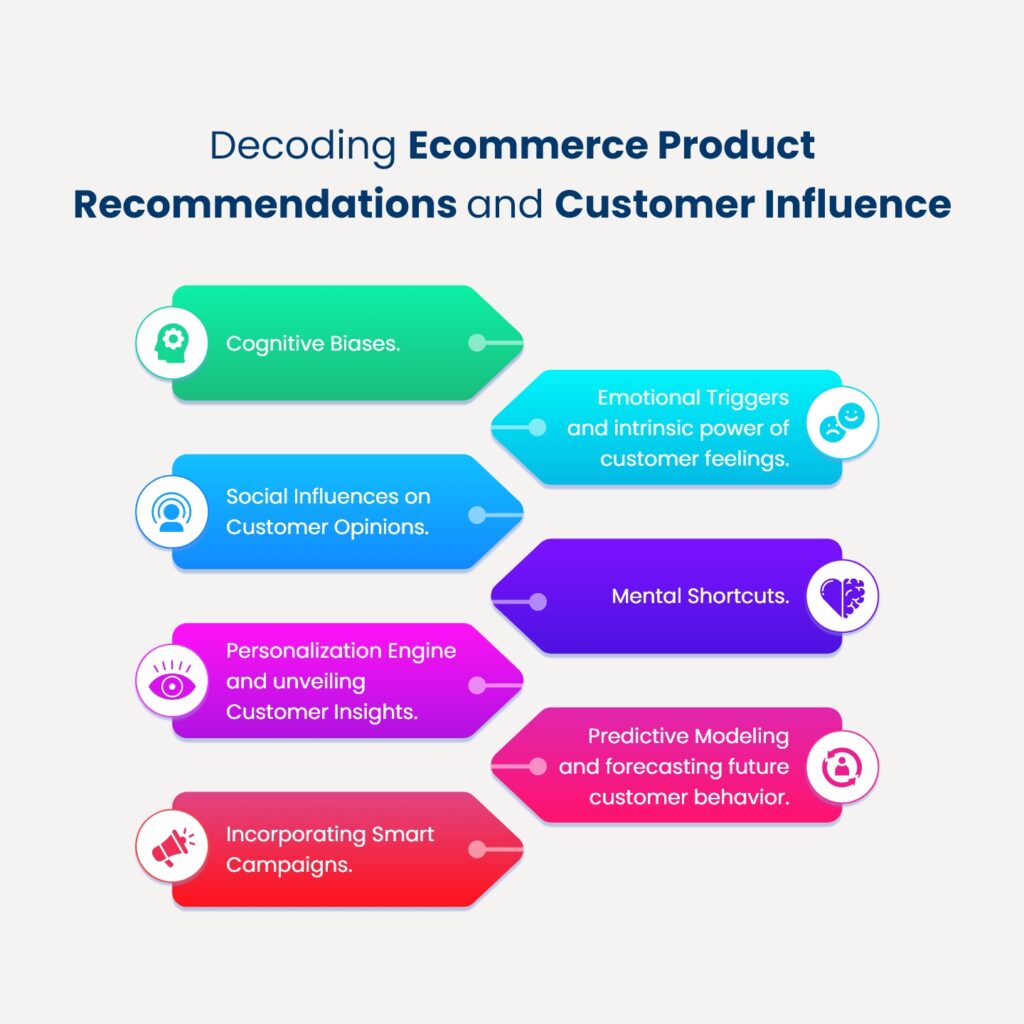Picture this: You’re navigating an online store, and suddenly, a curated list of products appears, seemingly tailored just for you. Ever wondered how Ecommerce product recommendations work its magic? So, in this exploration, we delve into the intricacies of recommender systems, smart campaigns, and a lot more, to understand the dynamic world of online shopping. Join us as we unravel the fascinating landscape of Ecommerce, where technology-driven strategies are transforming the way businesses connect with their customers.
The Science Behind Product Recommendations: Delving into Customer Psychology
The concept of Ecommerce product recommendations is grounded in the principles of human psychology, tapping into cognitive biases, emotional triggers, and social influences that shape consumer behavior. These recommendations go beyond simply suggesting products based on purchase history; they delve into the deeper motivations and preferences that drive purchasing decisions. To effectively measure the impact of ecommerce product recommendation, businesses must track key metrics such as click-through rates, conversion rates, and average order value. Talking of conversion rates, research from McKinsey & Company found that product recommendations can increase conversion rates by up to 300%. Today, numerous ecommerce giants have successfully implemented product recommendation systems to drive business growth.
For instance, Amazon uses its recommendation engine to suggest products to customers based on their past purchases, browsing history, and product reviews. This personalized approach has been instrumental in Amazon’s success, contributing significantly to its customer satisfaction and sales figures.
Cognitive Biases: The Hidden Forces Guiding Choices
Cognitive biases and mental shortcuts that simplify decision-making, play a significant role in how customers respond to product recommendations. The anchoring effect, for instance, leads customers to rely heavily on the first piece of information they receive, making recommendations that appear early more influential. Similarly, the sunk cost fallacy can motivate customers to continue investing in a product or service, making recommendations that align with previous purchases more persuasive. On a similar note, according to a study by Barilliance, personalized product recommendations can account for up to 31% of e-commerce site revenues, which is commendable to say the least. Similarly, a report by Monetate says that customers who interacted with product recommendations had a boost in average cart value by 5.5%.
Emotional Triggers: Tapping into the Power of Feelings
Emotions play a powerful role in influencing customer decisions, making emotional triggers a critical component of effective product recommendations. By evoking positive emotions like excitement, joy, and anticipation, recommendations can capture customer attention and increase the likelihood of a purchase. For example, highlighting product reviews that convey satisfaction or showcasing positive customer testimonials can trigger positive emotions and encourage conversions.
Likewise, Netflix has set up 1,300 recommendation clusters based on users’ positive viewing preferences. As a result, whenever you turn on Netflix, you come across a list of movies and TV shows tailored to your interests and user profile. The goal here is nothing but to help each user find a movie or a TV show as quickly as possible (estimated 90 seconds only).
Social Influences: The Impact of Others’ Opinions
Humans are social creatures, and their decisions are often influenced by the opinions and behaviors of others. Social proof, the phenomenon of conforming to the actions of others, can be harnessed to enhance the effectiveness of product recommendations. By displaying the number of people who have purchased or reviewed a product, recommendations can leverage social influence to increase customer confidence and encourage purchases.

Harnessing the Power of Recommendations: Strategies for Success
So, to effectively utilize product recommendations and influence customer decisions, ecommerce businesses must employ a strategic approach. Here’s how:
1. Personalization Engine: Unveiling Customer Insights
A personalization engine, powered by machine learning and artificial intelligence, is essential for gathering and analyzing customer insights. By collecting data on demographics, browsing behavior, purchase history, and product reviews, the engine creates detailed customer profiles that inform the recommendation algorithm. For instance, according to Accenture, nearly 91% of consumers are more likely to shop with brands that provide relevant personalized offers as well as recommendations. Again, 71% of consumers feel frustrated when a shopping experience is not personalized.
2. Predictive Modeling: Anticipating Future Needs
Predictive modeling, a key component of product recommendation systems, utilizes statistical techniques to anticipate future customer behavior. By analyzing historical data and current trends, these models can identify patterns and correlations that suggest which products a customer is likely to purchase in the future.
3. Smart Campaigns: Tailored Recommendations for Specific Segments
Smart campaigns allow businesses to tailor product recommendations to specific customer segments, product categories, or even individual purchase occasions. By segmenting their customer base, businesses can ensure that each customer receives a personalized and relevant recommendation, maximizing the impact of this marketing strategy. Also, to craft potent smart campaigns, businesses must harness Effective retargeting strategies pivot on intelligent customer insights.
Data-Driven Insights: Figures on Successful Ecommerce Product Recommendation
- A study by SalesCycle found that cart abandonment emails with personalized product recommendations had an average conversion rate of 22.2%
- Again, 37% of shoppers that clicked a recommendation during their first visit returned, compared to just 19% of shoppers that didn’t click a recommendation during their first visit.
- Boostcommerce says 37% of shoppers that click on a product recommendation return to the site after their first visit, while consumers that interact with product recommendations are 4.5x more likely to add items to their cart and complete a purchase. Likewise, 52% of orders from customers that clicked on product recommendations include a recommended product
- Also, the Global Recommendation Engine Market size is expected to reach $11.4 billion by 2027, rising at a market growth of 32.5% CAGR during the forecast period.
The Future of Product Recommendations: Personalization at its Core
So, as the statistics and numbers say, the ecommerce landscape continues to evolve and so does the product recommendation. Personalization remains at the forefront, with businesses leveraging deeper customer insights and advanced algorithms to create increasingly personalized and relevant recommendations. Moreover, the integration of artificial intelligence and machine learning further enhances the effectiveness of recommendations today, making them more predictive, dynamic, and responsive to individual customer needs.
Takeaway
Hence, understanding the psychology behind ecommerce product recommendation is essential for businesses to influence customer decisions effectively and drive business growth. By harnessing the power of cognitive biases, emotional triggers, and social influences, businesses can create personalized experiences that resonate with individual customers, leading to increased satisfaction, loyalty, and sales. And as the future of ecommerce unfolds, personalization will remain at the core of product recommendations, empowering businesses to create tailored experiences that foster customer delight and drive business success effectively!


